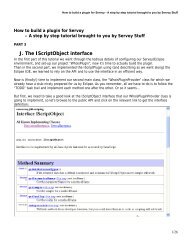Step by step tutorial: how to build a bean for Servoy - Servoy Stuff
Step by step tutorial: how to build a bean for Servoy - Servoy Stuff
Step by step tutorial: how to build a bean for Servoy - Servoy Stuff
Create successful ePaper yourself
Turn your PDF publications into a flip-book with our unique Google optimized e-Paper software.
How <strong>to</strong> <strong>build</strong> a <strong>bean</strong> <strong>for</strong> <strong>Servoy</strong> - A <strong>step</strong> <strong>by</strong> <strong>step</strong> <strong>tu<strong>to</strong>rial</strong> brought <strong>to</strong> you <strong>by</strong> <strong>Servoy</strong> <strong>Stuff</strong><br />
And we know about the initialize() method, but we don’t really need <strong>to</strong> keep a pointer on the <strong>Servoy</strong><br />
application (there will be no call back <strong>to</strong> JS methods in our simple <strong>bean</strong>), so we can ignore:<br />
public void initialize(IClientPluginAccess paramIClientPluginAccess) {<br />
// ignore<br />
}<br />
For the isReadOnly() method we will also keep it simple and call the JTextField isEnabled() method:<br />
public boolean isReadOnly() {<br />
return !isEnabled();<br />
}<br />
Then we can also ignore the setValidationEnabled() method call, since our <strong>bean</strong> is going <strong>to</strong> allow any<br />
kind of text – there will be no validation anyway:<br />
public void setValidationEnabled(boolean validationEnabled) {<br />
// ignore<br />
}<br />
Finally the s<strong>to</strong>pUIEditing() method is called each time <strong>Servoy</strong> wants <strong>to</strong> retrieve the data, and if it can,<br />
the method must return true (remember), so let’s do it simply like that:<br />
public boolean s<strong>to</strong>pUIEditing(boolean paramBoolean) {<br />
return true;<br />
}<br />
And then we have our dataProviderID getter and setter, so let’s implement them also:<br />
public String getDataProviderID() {<br />
return dataProviderID;<br />
}<br />
public void setDataProviderID(String dataProviderID) {<br />
this.dataProviderID = dataProviderID;<br />
}<br />
Now we are only left with the setSelectedRecord() method. You remember from our <strong>Servoy</strong>SliderBean<br />
that it contained a few tests:<br />
if (currentFoundset != null &&<br />
currentFoundset.getSize() > 0 && currentRecord != null) {<br />
if (hasDataProvider()&& isContainedInFoundset(getDataProviderID())) {<br />
Now we know that we are going <strong>to</strong> need the same kind of code <strong>for</strong> the Wicket <strong>bean</strong>, so it would be a<br />
good idea if we could put these tests in<strong>to</strong> one single method that would be accessible from both class<br />
(the Swing <strong>bean</strong> and the Wicket <strong>bean</strong>).<br />
That’s the idea <strong>for</strong> a new “helper” class. So let’s create a class that will have this method and add it <strong>to</strong><br />
our package. I named mine “<strong>Servoy</strong>Utils” in the “net.stuff.servoy.<strong>bean</strong>s.test” package. Now the best<br />
thing would be if that utility class could be called without the need <strong>to</strong> instantiate it (no “new” object<br />
created <strong>to</strong> access its methods), so we are going <strong>to</strong> put some static methods in it.<br />
But wait! What about concurrency, what about threading The thing is that you can use static methods<br />
safely in a multi-thread environment, but the only condition is that they will only use external objects<br />
(given as parameters) and not modify them! So that’s fine in our case because we want a utility<br />
method which is going <strong>to</strong> read from the objects passed in parameters, lets code the following:<br />
4/37



